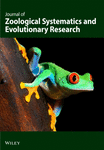Genetic and morphological relationships of the Berlenga wall lizard (Podarcis bocagei berlengensis: Lacertidae)
Abstract
Six biometric characters and 15 electrophoretic loci of three known subspecies of Podarcis bocagei were studied. Contrary to biometric indications, Podarcis bocagei berlengensis showed a closer genetic relationship with Podarcis bocagei carbonelli than with the nominal subspecies. The biometric results were confounded by the relative large size of P. b. berlengensis. Post-glacial colonization from two different areas might explain the greater genetic differentiation between the P. b. bocagei and P. b. carbonelli populations (Nei's D - 0.158 - near the species threshold). It might also explain the known colonization of these two lizards through the islands off the west coast of the Iberian penninsula and their present distributions to the north of (Galicia; Northern Portugal) and to the south of the valley of river Douro (central Portugal, western and Sistema Central), respectively.




